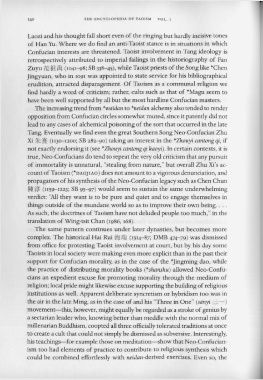Page 180 - The Encyclopedia of Taoism v1_A-L
P. 180
140 T H E ENC YCLO PE DI A OF TAO ISM VOL. I
Laozi and his thought fall short even of the ringing but hardly incisive tones
of Han Yu. Where we do find an anti-Taoist stance is in situations in which
Confucian interests are threatened. Taoist involvement in Tang ideology is
retrospectively attributed to imperial failings in the historiography of Fan
Zuyu mtEl ~ (I041- 98; SB 338- 45), while Taoist priests of the Song like *Chen
Jingyuan, who in 1091 was appointed to state service for his bibliographical
erudition, attracted disparagement. Of Taoism as a communal religion we
find hardly a word of criticism; rather, cults such as that of *Magu seem to
have been well supported by all but the most hardline Confucian masters.
The increasing trend from *waidan to *neidan alchemy also tended to render
opposition from Confucian circles somewhat muted, since it patently did not
lead to any cases of alchemical poisoning of the sort that occurred in the late
Tang. Eventually we find even the great Southern Song Neo-Confucian Zhu
Xi ** (1130-1200; SB 282-90) taking an interest in the *Zhouyi cantong qi, if
not exactly endorsing it (see *Zhouyi cantong qi kaoyi). In certain contexts, it is
true, Neo-Confucians do tend to repeat the very old criticism that any pursuit
of immortality is unnatural, "stealing from nature," but overall Zhu Xi's ac-
count of Taoism (*OAO]IAO) does not amount to a vigorous denunciation, and
propagators of his synthesis of the Neo-Confucian legacy such as Chen Chun
~1$ (1159-1223; SB 95-97) would seem to sustain the same underwhelming
verdict: 'l\ll they want is to be pure and quiet and to engage themselves in
things outside of the mundane world so as to improve their own being . . ..
As such, the doctrines of Taoism have not deluded people too much," in the
translation of Wing-tsit Chan (1986, 168).
The same pattern continues under later dynasties, but becomes more
complex. The historical Hai Rui #tifi!Tl (1514- 87; DMB 474-79) was dismissed
from office for protesting Taoist involvement at court, but by his day some
Taoists in local society were making even more explicit than in the past their
support for Confucian morality, as in the case of the *Jingming dao, while
the practice of distributing morality books (*shanshu) allowed Neo-Confu-
cians an expedient excuse for promoting morality through the medium of
religion; local pride might likewise excuse supporting the building of religious
institutions as well. Apparent deliberate syncretism or hybridism too was in
the air in the late Ming, as in the case of and his "Three in One" (sanyi -= - )
movement- this, however, might equally be regarded as a stroke of genius by
a sectarian leader who, knowing better than meddle with the normal mix of
millenarian Buddhism, coopted all three officially tolerated traditions at once
to create a cult that could not simply be dismissed as subversive. Interestingly,
his teachings-for example those on meditation- show that Neo-Confucian-
ism too had elements of practice to contribute to religious synthesis which
could be combined effortlessly with neidan-derived exercises. Even so, the

